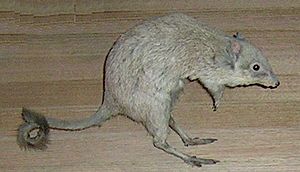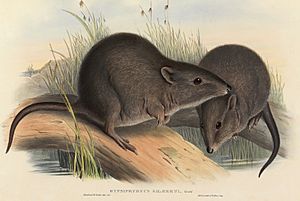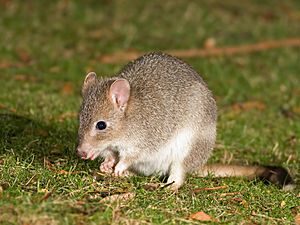Potoroidae facts for kids
Quick facts for kids Potoroidae |
|
|---|---|
 |
|
| Woylie (Bettongia penicillata) | |
| Scientific classification |
|
| Kingdom: | Animalia |
| Phylum: | Chordata |
| Class: | Mammalia |
| Infraclass: | Marsupialia |
| Order: | Diprotodontia |
| Suborder: | Macropodiformes |
| Family: | Potoroidae Gray, 1821 |
Potoroidae is a family of small Australian marsupials. These amazing animals are known by different names like bettongs, potoroos, and rat-kangaroos. They are about the size of a rabbit, usually brown, and move by hopping. They might remind you of a large rodent or a very tiny wallaby.
Contents
What Are Potoroids?
Potoroids are like smaller cousins to kangaroos and wallabies. They might even be ancestors of these larger hopping animals! Their teeth are a bit simpler than kangaroos. They have longer upper incisors (front teeth), bigger canines, and four bumps on their molars. Both potoroids and kangaroos have a wide gap, called a diastema, between their front teeth and their back teeth.
How Potoroids Move
Even though they are smaller, potoroids move a lot like small wallabies. They have long back feet and mostly hop to get around. However, they are not as extreme as true wallabies. They can also use their front paws to move more slowly, just like rabbits do.
What Potoroids Eat
Like most marsupials in their group (called diprotodonts), potoroids are herbivores. This means they eat plants. They enjoy many different kinds of plant foods. But many potoroids especially love to eat fungi, like mushrooms. Fungi often help them survive when other food is hard to find in the dry Australian bush. For example, the long-footed potoroo eats mostly fungal spores. Because of this, it needs to live in damp places with lots of plants to hide from predators like foxes and feral cats.
Their Important Role in Nature
Long ago, there were many potoroids. They played a big part in keeping the soil healthy. They would dig for fungi and other foods under the ground. This digging helped to loosen the soil, which was important for the plants growing above. They were considered very important for the health of the Australian environment.
Why Potoroids Need Our Help
Sadly, many species of bettongs and potoroos are now in danger, and some have even become extinct. This happened because settlers took away much of their natural home. Also, new animals like red foxes and feral cats, which were brought to Australia by settlers, hunted many potoroids.
In the past, different kinds of bettongs lived all over Australia. Today, the Tasmanian bettong only lives in the eastern part of Tasmania. The northern bettong is found in only three small areas in northern Queensland. Many potoroid species have disappeared from most of the places they used to live. Now, people are working hard to protect them in special areas and help their populations grow again.
Potoroid Family Tree
Potoroids are a basic branch of the macropod family. Today, there are three main groups (genera) of potoroids, with eight different species. Scientists have studied their genes to understand how they are related to other animals.
Here is a simple list of some of the potoroid groups, including those that are now extinct:
- family Potoroidae
-
- subfamily †Palaeopotoroinae
-
- genus Palaeopotorous
- subfamily Potoroinae
-
- genus Aepyprymnus
- genus Bettongia
- genus †Borungboodie
- genus †Milliyowi
- genus †Caloprymnus
- genus Potorous
- genus †Purtia
- genus †Wakiewakie
- genus †Gumardee
- subfamily †Bulungamayinae
-
- genus Bulungamaya
- genus Wabularoo
- genus Wanburoo
- genus Nowidgee
- genus Ganguroo
Images for kids
-
Woylie (Bettongia penicillata)
See also
 In Spanish: Potoroidos para niños
In Spanish: Potoroidos para niños
- ARKive - images and movies of the burrowing bettong (Bettongia lesueur)






